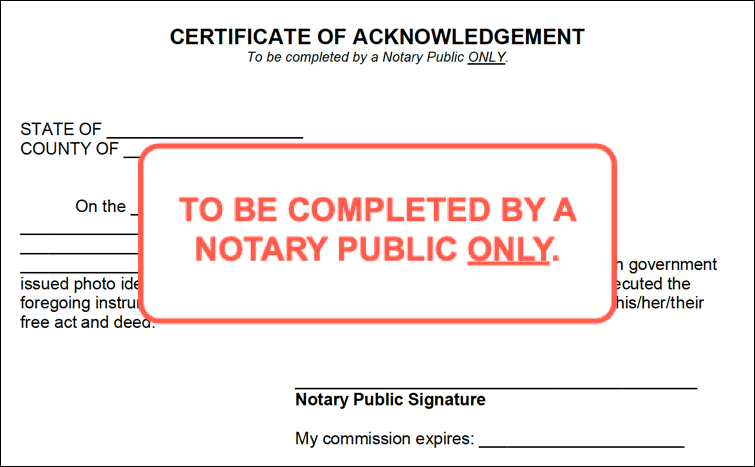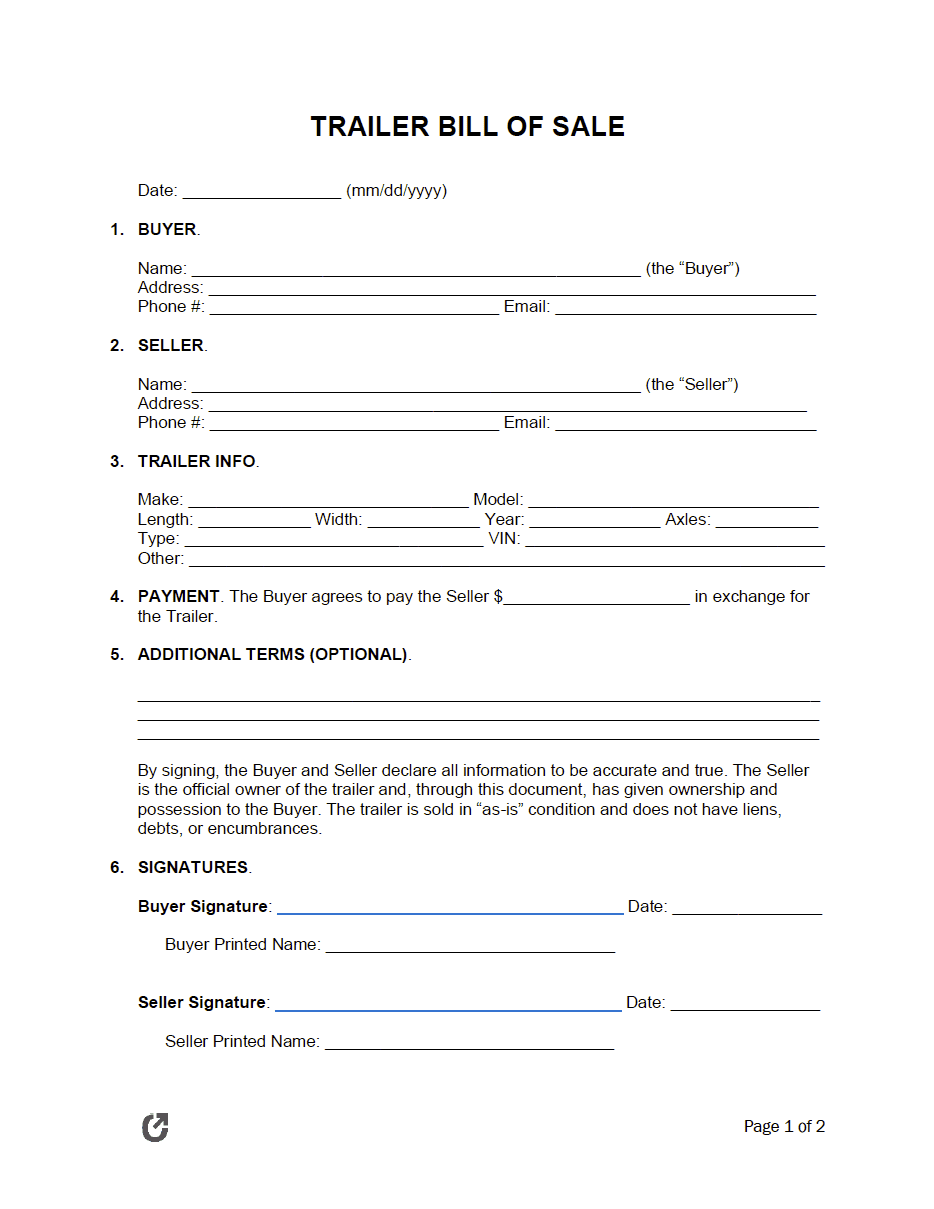Trailer Bill of Sale Form
A trailer bill of sale form records the transfer of a carrying platform from one person to another. Utility trailers consist of horizontal boards encaged in plastic or metal that attach to a vehicle, boat, or ATV. Their purpose is to transport large or heavy goods in a safe, controlled manner. There are four main types: 1) enclosed, 2) open-air, 3) flatbed, and 4) landscape.
| Summary |

By State
- Alabama
- Alaska
- Arizona
- Arkansas
- California
- Colorado
- Connecticut
- Delaware
- Florida
- Georgia
- Hawaii
- Idaho
- Illinois
- Indiana
- Iowa
- Kansas
- Kentucky
- Louisiana
- Maine
- Maryland
- Massachusetts
- Michigan
- Minnesota
- Mississippi
- Missouri
- Montana
- Nebraska
- Nevada
- New Hampshire
- New Jersey
- New Mexico
- New York
- North Carolina
- North Dakota
- Ohio
- Oklahoma
- Oregon
- Pennsylvania
- Rhode Island
- South Carolina
- South Dakota
- Tennessee
- Texas
- Utah
- Vermont
- Virginia
- Washington
- Washington D.C.
- West Virginia
- Wisconsin
- Wyoming
What is a Trailer Bill of Sale?
A trailer bill of sale reassigns ownership of equipment used for transporting items. They can hold farming supplies, boats, snowmobiles, all-terrain vehicles, and other heavy machines or equipment. The seller discusses the trailer’s condition, sale price, and payment method with the buyer, then uses this information to complete the document.
Its value depends on many factors, such as its type, size, age, manufacturer, and materials used. Open-air trailers do not have a covering, meaning they provide less protection to the cargo. On the other hand, enclosed trailers stow the object in a walled container and shelter it from damage.
How to Sell a Trailer (6 Steps)
Reference the following six (6) steps to transfer ownership of a utility trailer.
Step One – Determine a Price
Setting a realistic price attracts buyers and ensures that the seller receives an adequate amount for the trailer. Therefore, the owner should consider the condition, manufacturer, age, and usability of the trailer. They can determine a price using this information and by comparing it to similar models. Online resources and dealerships can also provide accurate data if desired.
Step Two – Advertise the Trailer
Choosing the best and most relevant listing agency for trailers helps to let others know about the sale and ensures it has a realistic selling price. Sellers use websites, such as eBay, Craigslist, and Facebook Marketplace. However, individuals can also place ads in local newspapers or fliers or create yard signs.
Ensure that the description is easy-to-read, accurate, and includes clear and helpful images, so the reader comprehends the trailer’s quality.
Once listed, potential buyers will start to reach out. Respond to any questions that come up and schedule tours as necessary.
Step Three – Meet with Interested Buyers
Set up appointments with interested candidates so they can look at the trailer. Make sure that it is in an easily accessible location and take time to clean it before touring.
Think about how you will handle the situation if the buyer tries to negotiate. Sellers often set a minimum price before the meeting as it guarantees they receive a fair profit.
Step Four – Complete Trailer Bill of Sale
Once the buyer and seller agree on a price, they complete a trailer bill of sale. They include their contact information, the trailer’s description, price, and the payment method. The written details summarize how the transfer occurred and outline the agreement.
Both parties must sign to affirm their arrangement. If the buyer and seller decide to have the form notarized, they must wait until they are in front of a notary public to sign.
Step Five – Notarization (Optional)
Although not necessary, notarization boosts the document’s credibility in the eyes of the DMV. A notary public is a certified individual who works at law offices, shipment facilities, libraries, and other locations.
To notarize the document, the buyer and seller bring the unsigned bill of sale and a form of photo identification (i.e., driver’s license, state ID, etc.) to the authorized person.
The notary public reviews the identification documents and confirms each person’s name, address, and birth date. Next, the individual instructs the buyer and seller to sign the form.
After this step, they authorize the form using an official stamp, seal, or signature. The court recognizes this acknowledgment, thus giving it more power in legal cases.
Step Six – Transfer Trailer
After completing the form, notarizing it, and transferring funds, the seller gives the buyer the trailer and accessories (i.e., keys, locks, etc.).
Buyers should only give money to the seller if they know the deal will happen. In other words, they should not pay the owner days in advance or online as scams can occur this way.
Similarly, sellers should not give the buyer the trailer unless the person has paid for it in full. It is important to note that individuals cannot use a bill of sale as a payment plan. Instead, the buyer must pay the entire amount at the time of the transfer.
Registration Laws: By State
The utility trailer’s weight determines most states’ registration and titling requirements. For the purpose of this chart, a utility trailer is a non-commercial, private use carrying platform with a weight of 1,000 pounds (loaded).
Frequently Asked Questions (FAQ)
Read the following commonly asked questions about buying, selling, and owning a utility trailer.
Does a Utility Trailer Have To Be Registered?
Sometimes. Each state has unique laws for registration and titling. For this reason, the owner should research state laws to ensure they have taken the necessary steps in the acquisition and registration process.
If the state requires registration, the owner must provide a completed trailer bill of sale form to the Department of Motor Vehicles (DMV) in most cases.
Do You Need a Bill of Sale For a Trailer?
It depends. The seller often includes a trailer in a boat or vehicle sale; however, they can also sell it separately. In this case, it is appropriate to use a trailer bill of sale form. Residents must complete a bill of sale form in states that require it to obtain a registration and title.
Regardless of state laws, completing a trailer bill of sale is recommended. The document verifies that the buyer paid for the item and received ownership.
Without the form, neither party can legally prove the sale occurred. This situation becomes challenging if questions arise after the sale or something goes wrong with the trailer. Overall, it increases the likelihood of legal claims and accusations. Therefore, both parties safeguard themselves by utilizing the form during the sale.
Can I Register a Trailer With a Bill of Sale?
Yes. States that require registration accept bill of sale forms as proof of purchase. The buyer and seller must fill out the document together, ensuring they include accurate and up-to-date information. An official signature from each person finalizes the form as it indicates their mutual agreement.
How to Write a Trailer Bill of Sale (7 Steps)
Follow the steps below to complete a trailer bill of sale form.
Step One – Date of Sale
Enter the day the sale occurred in a two-digit month, two-digit day, four-digit year format.
![]()
Step Two – Buyer + Seller Personal Details
Each person involved in the deal must inscribe their full name, home address, home or cellphone number, and active email.

Step Three – Trailer Information
Write the following identifying details of the trailer:
- Make
- Model
- Length
- Width
- Year
- Axles
- Type
- Vehicle Identification Number (VIN)
- Other

Step Four – Payment
State the amount of money that the buyer paid for the trailer.
![]()
Step Five – Additional Terms (Optional)
The buyer and seller do not have to complete this section. However, it is essential if both parties have agreed to otherwise unspecified conditions.
For example, if the owner traded or gifted the trailer, they must write the details here. They can also utilize this space to record the payment method (i.e., cash, check, money order, or credit card).

Step Six – Signatures
After agreeing to the listed information and price, the merchant and purchaser sign, making the document official. Both parties must wait to sign if they plan to notarize the form.

Step Seven – Notarization (Optional)
If the buyer and seller have decided to notarize the document, they must bring the unsigned form and ID to a notary public. The individual checks their identity and then witnesses their signing. They authenticate the bill of sale using a seal, stamp, or signature.


